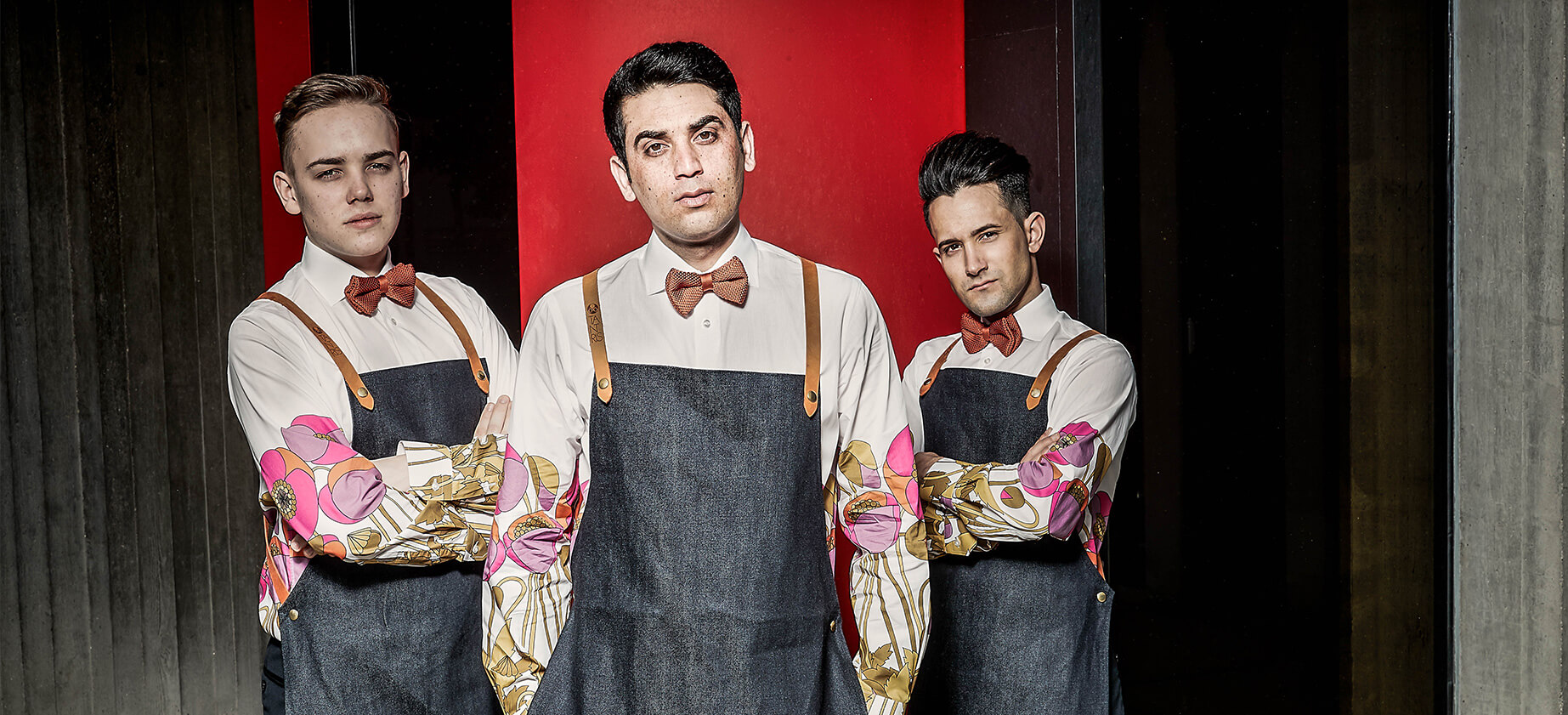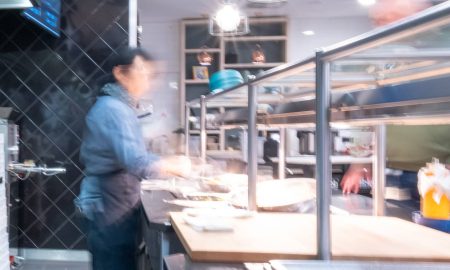Food takes center stage. That’s the thought behind an old tradition in the hospitality industry: employee clothing should be as neutral as possible. Even in places where the architecture and decor are flashy, avant-garde spectacles, the fun stops when it comes to the uniforms. Or does it? Mixing creative influences is all the rage these days, and restaurateurs are beginning to put their own distinctive touches on the staff dress code. Music, art, fashion, architecture, design, and food… the lines among them are blurring more and more. This interdisciplinary approach is leading some places to think outside the shapeless, black-and-white polyester box in favor of brightly colored, sustainably produced designer creations.
Cuisine meets couture
The Munich restaurant Tantris isn’t just beloved for its haute cuisine; if anything, it’s equally known for its retro-futuristic interior. And for a few months now, the path from the kitchen to the dining area has become a regular catwalk. Talbot Runhof, a designer duo known primarily for elegant evening wear, developed a collection especially for the Tantris staff, one that reflects various design elements within the two-Michelin-starred location itself – including the flowered curtain in the 1970s women’s restroom, which probably shows up on Instagram every bit as often as their famous leek puree with caviar and nut butter. Now the pink-poppy pattern adorns swinging dresses. elegant button-down shirts, and feminine blouses; The tops are paired with marine-blue skirts and pants with red stripes.
Staff can choose up to five outfits, and can pair the individual pieces however they like. Everything is tailor-made, so the striking uniforms fit like gloves. They don denim aprons with leather ties to carry heavy trays; regular and bow ties are the same shade of orange as the wallpaper, and sneakers in the same shade are embroidered with the words “Bärenhunger” and “Affendurst” (which translate, roughly, to “hungry as a bear” and “thirsty as an ape”). Customized wait staff clothing is still a relatively recent trend, but at Tantris it’s already a tradition: Heinz Oestergaard designed a collection for the restaurant back in the 80s.
High-end Parisian workwear
“I’ve always found it odd that waiter clothing often seems like it has nothing to do with the rest of the restaurant.” Danish clothing designer Morten Thuesen and Italian designer Letizia Caramia specialize in restaurant and hotel uniforms. They previously worked under Isabel Marant and Alexander McQueen; today, they run Older, an atelier in Paris, and are considered rising stars on the fine dining scene. “We put just as much love into our aprons as we used to into evening dresses,” Thuesen says. They’re concerned with more than just visual appeal, though: the team at Older has developed a blend of organic cotton and recycled polyester that’s stain-resistant, environmentally friendly, breathable, and doesn’t need ironing. To them, design goes hand in hand with maximum comfort and convenience.
One of their first customers was the Noma in Copenhagen, for whom they created rustic aprons and collarless “grandpa shirts” that fit the world-renowned restaurant’s solid-wood ambiance perfectly. These days, their customer list reads like a who’s who of the restaurant world: the restaurant at the Tate Modern in London, Les Grand Verres at Palais du Tokyo in Paris, and now Under, the new underwater restaurant in Norway. But good taste doesn’t come cheap: one pinafore runs nearly a hundred euros.
Understatement and sustainability
One German entrepreneur trio thinks that’s a bit steep: Kaya & Kato offers similar aprons for less than a quarter of the Parisian’s price. The Cologne-based company’s motto is “Understatement and sustainability”, and they offer an impressively stylish collection of simple chef’s jackets, along with a wide variety of aprons. Environmental friendliness is the name of the game for Kaya & Kato, too – they manufacture their uniforms from recycled ocean trash. High quality, fair working conditions, and sustainability are major buzzwords in the hospitality industry as it is, and many restaurants have already made great strides on the procurement end of things, but employee uniforms still tend to fly under the radar. That’s what prompted Stefanie Rennicke, Stefan Rennicke and Lillo Scrimali, the minds behind Kaya & Kato, to take action.
The Rennickes have a background in PR, consultation, and developmental assistance; Lillo Scrimali is a successful music producer in his other life. In other words, they’re new to the restaurant and hotel industry, but they’re very passionate about their work. The three entrepreneurs started off experimenting with cotton-based products, but soon discovered that they didn’t hold up well to frequent, aggressive washing. Eventually, they settled on a blend of organic cotton and polyester. The former is sourced from Kyrgyzstan and Northwestern Uganda; the latter from a Spanish supplier who produces the material from recycled ocean trash.
Customized workwear for kitchen and dining areas is on the rise, though some Tantris customers are still getting used to the change – the restaurant has already taken some flak for their daring designs. Bayerischen Hof in Munich, who brought in Belgian designer Dries van Noten to help clothe their personnel more fashionably, had similar experiences. On the other hand, the Tantris executive management are receiving a great deal of positive feedback as well. Some people want to know whether they can buy the uniforms anywhere. Unfortunately not, they’re told. This is one designer collection that’s staff-only.
















